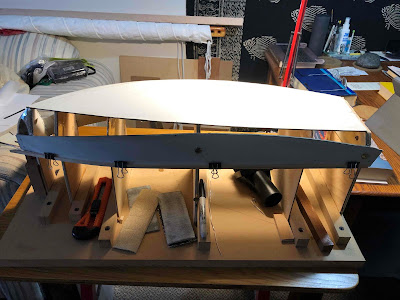I started building a model of my re-design of the sailboat in September of 2020 (see December 2019 entry "Next"). I actually started on the forms in the spring, and didn't get back to it in earnest until September. The model is 22.5" long and 7" wide.
The core of the model is paperboard, 'cause that's what I had enough of that I thought would be easy enough to work with. Balsa would have been much easier to work with, as the paperboard was very hard to cut, and when edges are sanded, they splay out as the inside of the board falls apart. It held the curves well, though.
I had my doubts as to whether the model was going to come off of the forms, so I didn't blog about it at the time.
The bilge panel was a trip to make and to install.
The outside has a layer of glass cloth in epoxy. The inside has a coat of epoxy. The insides of the chines have a somewhat messy fillet of epoxy with a silica filler; the bigger gaps have chopped glass as filler.
I want it to be able to sail, so it needs a functioning rudder. I made gudgeon eyes using the stainless wire I used when making the real-life sailboat. The "legs" of the eyes are bent over inside and held permanently in epoxy filled with glass.
The cotter pin, used to hold the eyes in line, was padded out to give the leading edge of the rudder space when turning. The cotter pin will be what holds the rudder to the boat, through matching eyes on the rudder.
The dark patches on the transom are where I sanded through the outer layer of the paperboard. The decks and bulkheads are balsa.
The wires in the photo below are prototypes of the wire eyes with long tails that I used for the rudder. On the left is the rudder being built, of popsicle sticks! 😃
Bulkheads are ready to install:
Next will be the side benches. Pro tip: vinegar works well to clean epoxy with; not quite as well as acetone, but friendlier.






















